 Most viewed Most viewed |

Nikon model in PIE 20057174 views
|
|

Yuka-chan, A.B.S.UNIDOS DO URBANA based in Nagoya at Asakusa Samba 2006.7062 views
|
|

Daihatsu5636 views
|
|

Pumping (or humping) the...5425 views
|
|

Belly dancer at Yushima Tenjin Plum Blossom Festival, Tokyo.5224 views
|
|

The 26th Asakusa Samba Carnival was held on Aug. 26, 2006. Some 4,500 members from 33 troupes paraded from 1:30 pm to 6 pm. About 500,000 people were on hand to watch.5064 views
|
|

Asakusa Samba Carnival4946 views
|
|

Asakusa Samba Carnival4924 views
|
|

Pentax model4563 views
|
|

Riding it...4361 viewsObviously I have better shots of her with her cute face showing and both arms in the air, but I'm not one to embarass people...
It has been scientifically proven that sex is good for your health and beauty.
|
|

The festival is wildly popular with people from overseas.4246 viewsThe shrine had various phallus props to pose with.
|
|

Oiran courtesan. Also see my photos of an oiran show here. My oiran video at YouTube here.4071 viewsThe highest-ranking geisha is called an oiran or tayu. She is escorted by two little attendant girls called kamuro. Notice her high clogs. It takes some skill to walk in those and she usually requires someone's shoulder to hold onto while walking. Sometimes at festivals or special events, you can see the Oiran Dochu procession where she walks in a parade together with geisha attendants.
|
|

Yuka-chan, A.B.S.UNIDOS DO URBANA based in Nagoya at Asakusa Samba 2008.4042 views
|
|

Licking it...3984 viewsLook at that tongue...
|
|

Golden Girl3983 views
|
|

Model for Canon Kiss Digital N3980 views
|
|

Ooohhh, ecstasy...3951 viewsNah, just joking. She was actually just embarassed and spontaneously covered her face with a giggle. Obviously I have better shots of her with her cute face showing, but I'm not one to embarass people... Boy, I wish I took a video clip of this scene.
Actually, what happened is that a guy sat on this black penis before she did, and she saw that. So she imitated and sat on it too. Her female friend was taking her picture. Later they switched places and her friend, who was wearing a skirt and red net stockings, sat on it and posed for pictures.
Notice the zigzag white paper streamers. They indicate something which is sacred. So this penis is sacred, possessing a divine spirit. I can believe this because it draws so many people to it. It definitely has divine power. I mean it made this girl sit on it right?
|
|

Dickhead hat. Actually, I don't know what they call it, but that's what I call it.3936 views
|
|

Carving daikon. Anybody can join in and carve. 大根削り3826 viewsLater to be auctioned off.
|
|

Now this is a work of art. Bid at least 3,000 yen please...3760 viewsA Japanese woman bought this, but no takers for the mochi phallus (also 3,000 yen minimum).
|
|

The bottom of the woman figurine. Naughty, naughty...3756 views
|
|

Lollipop, lollipop, oh lolly-lollipop (pop!)...3735 viewsFrom an old song. These lollipops were selling like hotcakes.
|
|
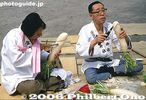
Carving daikon (old photo). These men were really good at carving the daikon.3729 views
|
|

Yuka-chan, A.B.S.UNIDOS DO URBANA based in Nagoya at Asakusa Samba 2006.3711 views
|
|

Procession maidens pose with wooden penises.3669 views
|
|

Mitsubishi Motors3648 views
|
|

Kawasaki ZZR 1400 ABS motorcycle3608 viewsI looked at her and she smiled.
|
|

Daihatsu SK-Tourer3548 views
|
|

Shimada hairstyle3526 viewsStandard hairstyle for geisha. This a wig.
|
|

Harley-Davidson FLST Heritage Softail3475 viewsWorld premiere of this bike.
|
|

Procession maidens pose with wooden penises. Tagata Shrine Honen Festival3344 views
|
|

It sure reminds you of the James Bond movie, "Goldfinger" where a girl was turned into gold.3132 views
|
|

The Crown Prince, the Emperor, and the Empress on the Emperor's Birthday. They were on the balcony for a whole THREE minutes. I thought they would stay there for at least 10 min. Barely had time to mount my telephoto lens.2857 views
|
|
|

Rear view2681 views
|
|

Asakusa Samba Carnival2650 views
|
|

Painting inside Kanayama Shrine2649 views
|
|

Daihatsu. I smiled at her, and she smiled back...2635 views
|
|
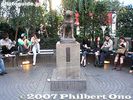
Shibuya Station, Hachiko statue2616 views
|
|

10:23 am: They wave to the crowd again. From left to right is the Crown Prince, the Emperor, the Empress, and Prince and Princess Akishino.2581 viewsIt was very difficult to get a good shot of them since so many flags were in the way. I had to hold the camera overhead above the flags and shoot almost blindly with my telephoto lens. Luckily, I managed to get a few decent closeup shots.
|
|
|
|

Sake flask2555 views
|
|

Daihatsu2553 views
|
|

2540 views
|
|

Yuka-chan, A.B.S.UNIDOS DO URBANA based in Nagoya at Asakusa Samba 2006.2503 views
|
|

Oiran Dochu Procession, Tokyo Jidai Matsuri2466 views
|
|

2. Sumidagawa (Sumida River)2464 views
|
|

Forging a steel phallus (old photo)2430 viewsThe demon living in the vagina of the women bit the man's phallus each time. So one guy made a steel phallus and the demom broke his teeth.
|
|

"Blue Ocean Waves" (青海波)2421 viewsThey performed four numbers. This first one was called "Blue Ocean Waves" performed by five geisha.
|
|

Carving daikon. Since some activities are conducted on the ground, the festival is also called Jibeta (Ground) Matsuri.2418 viewsOnce upon a time, the festival was still mostly a local event with much fewer people.
|
|

Lyrics of Kibo no Fune--Uminoko Shukoka (Ship of Hope--Lake Child Cruise Song). They created a song just for the boat in 1984. 希望の船--湖の子周航歌2415 viewsThis is the 1st verse:
朝もやはれて さわやかに
さざ波光る びわのうみ
ぼくらわたしら 滋賀の子が
湖上たのしく めぐりつつ
郷土の知識 たかめあう
希望の船よ 希望の船よ
湖の子よ
|
|

1. Fuji Murasaki (Purple Wisteria)2404 viewsDancer's name is Maiko 舞子
|
|

Lollipops2373 views
|
|

Way to Hakusan Shrine in Bunkyo Ward, Tokyo, near Hakusan Station on the Toei Mita Line and Hon-Magome Station on the Nanboku Line.2356 views
|
|

Otaru, Japan (July 4, 2006) - Fireworks burst off the coast of Otaru, during a 4th of July celebration for the officers and Sailors of the Kitty Hawk (CV 63) Carrier Strike Group. 2352 viewsOtaru, Japan (July 4, 2006) - Fireworks burst off the coast of Otaru, during a 4th of July celebration for the officers and Sailors of the Kitty Hawk (CV 63) Carrier Strike Group. Visitors from the Otaru area were invited aboard to join in an Independence Day reception, which included food, drinks and music. While in port Sailors will have a chance to sightsee, shop, enjoy recreational activities and participate in community relation projects. Currently in port, Kitty Hawk demonstrates power projection and sea control as the U.S. Navy's only forward-deployed aircraft carrier. U.S. Navy photo by Mass Communication Specialist Seaman Thomas J. Holt (RELEASED)
|
|
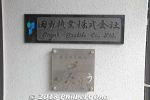
Visited a Tango chirimen company called Tayuh Textile Co., Ltd. (Tayuh Kigyo 田勇機業株式会社). 2343 viewshttp://www.tayuh.jp/
|
|

Tayuh Textile Co.'s chirimen textile factory in Kyotango.2343 views
|
|

2323 views
|
|

2287 views
|
|

The phallus is a symbol for themes of fertility.2250 views
|
|

Standing room only at Wakamiya Shrine2237 views
|
|
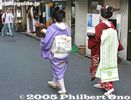
A geisha/geiko and maiko head to the theater to see the Kamogawa Odori. Notice the different obi sash on the back.2234 viewsA maiko is an apprentice geisha. Her obi sah on the back is long, as well as her sleeves.
|
|

Lobby of Tayuh Textile Co.2211 views
|
|

Kagurazaka geisha dance2210 views
|
|

Prayers to the Kanamara-bune mikoshi かなまら舟神輿2183 viewsBefore the portable shrine is taken out to be paraded around town, the god of the shrine must be transferred to it. This is what the head priest is doing.
|
|

Kanayama Jinja Shrine is a small shrine within the grounds of the Wakamiya Hachimangu Shrine near Kawasaki Daishi Station. On the first Sun. of April, it holds this now-famous Kanamara Festival nicknamed the Phallus or Fertility Festival. 2176 viewsFestival starts at 11 am. But a large crowd was already there well before that time. Entrance to shrine on the day of the Kanamara Festival. (If you're below age 18, please leave now.)
|
|

Nude woman lying down2169 views
|
|

Praying at Bishamon2166 views
|
|

Kagurazaka geisha dance2098 views
|
|

Male and female lollipops (mass produced). Cute, but we all prefer the real thing, right?2095 views
|
|

10:22 am: The Emperor speaks. When the Emperor spoke, the crowd immediately fell silent and all the flags stopped waving. He spoke for only about a minute, thanking us for celebrating his birthday and mentioning this past year's numerous natural disas2089 viewsAfter he finished, everyone waved the flags again and cheered.
|
|

Nose job2086 viewsI didn't see this among the souvenirs being sold. Wonder where he got it.
|
|

2074 views
|
|

Out of all the geisha that have appeared on postcards, this ever-smiling geisha was unsurpassed in popularity. Her smiling visage appeared in 40 to 50 different poses in photographs and postcards made in Yokohama from the 1890s.2047 views
|
|

The oiran courtesan is escorted by two little girls called kamuro. 花の吉原おいらん道中2037 views
|
|

Geisha chocolate ゲイシャ チョコ2029 viewsSome years ago, when a Finnish friend visited Japan and gave me this Geisha chocolate from Finland, I was very amused. Why in the world did they name it "geisha??" It's milk chocolate with a soft hazelnut filling.
Then when I went to Finland, I was surprised to see this chocolate brand almost everywhere. It's made by a company called Fazer, and when you look at their Web site, they explain in Finnish why they named it "geisha." (Wish I could read it.) The logo on the packaging uses a nice drawing of a geisha. But at the company's Web site, they have a wallpaper gallery showing a real human modeling as an obviously fake geisha.
No offense to the company, the model, makeup artist, and chocolate, but she is one of the worse-looking geisha models I've ever seen. Egad!! She might even be a man.
Take a look: http://www.fazermakeiset.fi/ Click on the Geisha button, then click on the fourth candy from the top to see the wallpaper.
After careful analysis, I know why Fazer's geisha looks so awful: Her fake wig is way too high above her ears. It's too small or too short for her (or his) head. The wig was probably for a young girl. See this photo and compare. They should stick to the cartoon logo instead.
この「Geisha」チョコはフィンランドに大人気。何故そう名付けたか分かりませんが(フィンランド語の説明がある)、数年前に初めてフィンランドの友人からもらったとき爆笑だった。そしてフィンランドへ初めて行ってこのGeishaチョコがどこでもあって驚きました。
Fazerという会社が作っていてHPを見るとなんと人間の「ゲイシャ」のモデルさんも登場している。このゲイシャのモデルもとても見苦しい。よく見ると、その桂が小さ過ぎて(または高すぎる)耳が丸見えてとても変な感じ。
HP: http://www.fazermakeiset.fi/
Geishaのボタンをクリックして、上から4番目のキャンデイをクリックするとそのモデルの壁紙がでる。いかがでしょうか。
|
|

Elizabeth portable shrine エリザベス神輿2024 viewsBefore the portable shrine is taken out to be paraded around town, the god of the shrine must be transferred to it. This is what the head priest is doing.
There are three portable shrines (called mikoshi). The Kanamara mikoshi (the original portable shrine), Kanamara-bune mikoshi (shaped like a boat), and Elizabeth mikoshi (pink giant). All three are carried during a procession around town. The Elizabeth mikoshi is carried by she-males. ("New half" in Japanese. Go ahead and laugh if you want.)
|
|

2020 viewsHer big round eyes makes her look like a real doll.
|
|

1996 views
|
|

Kunoichi female ninja guide1985 views
|
|

The second portable shrine and main attraction. It is 2.5 meters (13 feet) long, 60 cm diameter, and weighs about 300 kg. It takes 10 days to carve it from a cypress log.1964 views
|
|

1932 views
|
|

Sumo match with kids1909 viewsA retirement ceremony for an important sumo wrestler includes a variety of activities besides the actual ceremony of cutting away the topknot. It involves almost the entire Japan Sumo Association, and most wrestlers in the top three divisions (Makushita, Juryo, and Makunouchi) also appear in exhibition matches.
|
|
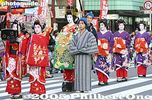
Oiran Dochu Procession. This is definitely the highlight of the festival, and my favorite part of the festival. 花の吉原おいらん道中1908 views
|
|

Male and female made of mochi (1000 yen)1885 views
|
|

YOKOSUKA, Japan (Sept. 23, 2007) - Rear Adm. Jamie Kelly, commander of Naval Forces Japan, speaks to a tour group aboard USS Kitty Hawk (CV 63) during a Friends and Family Cruise.1884 viewsYOKOSUKA, Japan (Sept. 23, 2007) - Rear Adm. Jamie Kelly, commander of Naval Forces Japan, speaks to a tour group aboard USS Kitty Hawk (CV 63) during a Friends and Family Cruise. Kitty Hawk brought aboard more than 2,200 American and Japanese guests for a day cruise, which included an air demonstration and shipboard tours. U.S. Navy photo by Mass Communication Specialist 3rd Class Dylan Butler (RELEASED)
|
|
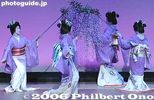
1. Fuji Murasaki (Purple Wisteria) by Kagurazaka geisha1869 views
|
|

Packed path to Wakamiya Hachimangu Shrine1865 views
|
|

1860 views
|
|

Two of the portable shrines ready to go. In Japanese, the festival is nicknamed "Chinko Matsuri" (Phallus Festival) ちんこ祭り.1858 viewsThere are three portable shrines (called mikoshi). The Kanamara mikoshi (the original portable shrine), Kanamara-bune mikoshi (shaped like a boat), and Elizabeth mikoshi (pink giant). All three are carried during a procession around town. The Elizabeth mikoshi is carried by she-males. ("New half" in Japanese. Go ahead and laugh if you want.)
|
|

Prayers to the Kanamara Boat portable shrine かなまら舟神輿 神輿御霊入れ式1851 viewsBefore the portable shrine is taken out to be paraded around town, the god of the shrine must be transferred to it. This is what the head priest is doing.
There are three portable shrines (called mikoshi). The Kanamara mikoshi (the original portable shrine), Kanamara-bune mikoshi (shaped like a boat), and Elizabeth mikoshi (pink giant). All three are carried during a procession around town. The Elizabeth mikoshi is carried by she-males. ("New half" in Japanese. Go ahead and laugh if you want.)
|
|
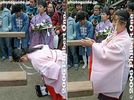
Prayers to the Elizabeth portable shrine エリザベス神輿1844 viewsBefore the portable shrine is taken out to be paraded around town, the god of the shrine must be transferred to it. This is what the head priest is doing.
|
|

The original exhibit showed a much more horrific faces and disfigurement with peeling skin down to their knees at least. I heard that they didn't want to make it too scary for children. Too bad.1835 views
|
|

1826 views
|
|

Procession maidens pose with the giant penis. The giant phallus was then partially hidden by the portable shrine as it is today. But this made the phallus become larger to 2.5 meters, as if to compensate for this partial shielding.1785 views
|
|

1778 views
|
|

Houkago Princess performing at Kanda Myojin Shrine for Setsubun.1777 views
|
|

1746 views
|
|

About the Sacred horse (pony).1743 views
|
|

"Boat tail" of a 1972 Buick Riviera. They long stopped making cars like this.1733 views
|
|

3. Edo no Nigiwai (Liveliness of Edo)1716 views
|
|

1705 views
|
|

Shibuya Station, Hachiko statue1696 views
|
|

Belly dancer at Fukushima Waraji Matsuri.1696 views
|
|

1. Fuji Murasaki (Purple Wisteria)1695 views
|
|

Ninja disguises1686 views
|
|

1683 views
|
|

Senbei crackers1683 views
|
|

Nagasaki photos by Yosuke Yamahata 山端庸介が原爆投下翌日の写真を撮った1666 viewsYosuke Yamahata was an Imperial Army photographer who was ordered to go to Nagasaki to photograph the after effects of the atomic bomb. He and two others, a writer and an artist, arrived in Nagasaki the morning after the bomb was dropped. Yamahata went on to capture over 100 extraordinary images of the devastation, people who survived, people helping the wounded, and the inevitable corpses.
山端庸介(1917−66)は陸軍報道カメラマンとして原爆投下翌日の長崎に入り,100枚以上の非常に貴重な歴史的の写真を撮った。長崎原爆資料館にも大きく展示されている。
|
|

Ninja costumes1666 views
|
|

1. Fuji Murasaki (Purple Wisteria)1653 views
|
|
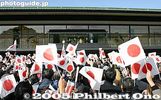
10:20 am: The Emperor and Empress appear right on time on his birthday. As soon as they appeared, people waved paper flags and cheered "banzai!" Also see the video at YouTube.1650 viewsIt was an amazing spectacle. I always saw it on TV, but this was the first time I saw it in person. I wish I went when Emperor Hirohito was still living.
From left to right is Princess Nori, the Crown Prince, the Emperor, the Empress, and Prince and Princess Akishino. Crown Princess Masako did not appear due to illness.
I also once used this shot for the cover photo on my home page.
|
|
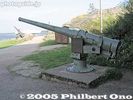
Japanese gun at Suomenlinna 明治時代の日本海軍の大砲1644 viewsWe were surprised to hear that Suomenlinna had a cannon from Japan. The Suomenlinna Visitor Center had a map in English called "The Guns of Suomenlinna" with all the cannons and guns listed (over 100), including the Japanese gun.
However, there was no explanation of the Japanese gun, and no one at the Visitor Center knew the history behind the Japanese gun. And I could not find any books in the Visitor Center gift shop that explained about the gun, like how in the world it got to Finland and Suomenlinna from faraway Japan.
But after returning to Japan, I did some reading and found out interesting things about it. On the Web, I found a few Japanese sites (but none in English) that mention this gun, and I found only one Web site with a picture of the gun. So I'm happy to show better pictures of the gun as well as an explanation in English.
This is what I found out so far:
The gun was made at Kure Naval Arsenal in Hiroshima Prefecture in 1898. (This can be confirmed by the inscription on the gun.) Kure was a major navy base.
After the Russo-Japanese War in 1904-05, Japan exported this gun to Russia. Before World War I broke out in 1914, Russia placed this 120mm-caliber gun on the coast to help defend the Gulf of Finland and St. Petersburg (or Petrograd as it was known during WWI) from possible attack by Germany. (Finland during this time was part of the Russian empire.)
After the Russian Bolshevik Revolution of 1917, Finland seized the opportunity and declared itself as an independent country which was approved by Russia. It thereby inherited this Japanese gun positioned in the former Russian territory now under Finnish control. For coastal defense, Finland used this gun as left by the Russians.
On Nov. 30, 1939, the Soviet Union attacked Finland with the intent to conquer it by the end of the year and make it a buffer state against hostile Nazi Germany. This started the Winter War with Finland which lasted until March 1940.
Although Finland's forces were greatly outnumbered by the Soviets, their guerrilla tactics and the severe winter inflicted heavy Soviet casualties. One major battlefront was near a small Finnish town called Taipale on the northwestern shore of Lake Ladoga near St. Petersburg. Taipale had two Finnish batteries, one of which was at Järisevä on the lakeshore, where the Japanese gun was stationed. (I'm not sure how the gun got to Taipale, whether the Russians had put it there from the beginning or whether the Finns moved it there from Finland's coast.)
Taipale was not too far from the border with the Soviet Union and was at the mouth of a small river called Taipaleenjoki. By Dec. 6, the Soviets from the southwest advanced far enough to reach the river on the side opposite of Taipale. What looked to be a piece of cake for the Soviets turned out to be a bloody battle lasting 3 months. The Finns proved to be ferocious fighters.
By Feb. 19, 1940, the Soviets finally started to make headway into the Finnish line of defense, called the Mannerheim Line that partially straddled along the Taipaleenjoki River, with heavy air and ground attacks. It was also the day when they attacked Taipale from both the east and west.
The west flank faced the ice on Lake Lagoda over which the Soviets marched, only to meet with artillery fire from the Järisevä battery on the lake shore. With the help of the damaged Japanese gun, the Finns destroyed two Soviet tanks and kept firing until they ran out of ammunition. The Soviet attack on Taipale from the west thus ended in failure, and the attack from the eastern flank was also futile. The lake ice was littered with dead Soviet soldiers. At the end of the war, the Finns carried their beloved Japanese gun back to Finnish territory even though it was damaged beyond repair.
Although Taipale never fell to the Soviets during battle, Finland was forced to cede the town and the entire region around northern Lake Ladoga (plus some territory in northeast Finland) to the Soviets in accordance with the Moscow Peace Treaty that ended the Winter War on March 12, 1940. These concessions understandably upset many Finns. Thousands of Finnish lives had been lost fighting for territory that was later handed over to the Soviets in peace. The ceded area was also Finland's industrial center and cradle of Finnish (Karelian) culture. The peace lasted only for about a year until both countries again fought each other during the Continuation War during June 1941 to September 1944.
Here's a little more background info about the gun researched by my friend Ronny Rönnqvist and edited by me:
Specifications
The gun is a derivative of the British 4.7 inch/40 (120mm/12cm) Amstrong-Elswick Naval/Coastal Gun, developed in the 1880s. The gun was manufactured under license in Japan by the Kure Naval Arsenal and used on Japanese cruisers of the late 1800s / early 1900s and later as a coastal defence gun.
In Japan the gun is known as Meiji 31st Year Type (120/41A) Kaigun Ho. (As inscribed on the gun in Japanese.) Some guns might have been taken by the Russians already during the Russo-Japanese war, but Japan also later on sold a quantity of these guns to Russia.
History
This particular gun in Suomenlinna is very famous in Finland. It belonged to 8 guns of this type left by the Russian Army in Finland after the War of liberation in 1917-18 when Finland won its independence. These guns were then used as coastal defence guns in various locations.
During the final days of the Winter War in 1940, the Fort of Järisevä in the Finnish town of Taipale on the western shore of Lake Ladoga (now in Russian territory near St. Petersburg) was defended by two such guns. In February only this gun was working when a Russian batallion approached over the lake ice on Feb. 19, 1940.
The gun had been hit and damaged (see the crack on the side of the barrel), but could be barely repaired in time in order to fire at the approaching enemy. By direct aiming and firing the gun with a hammer and although the barrel was badly damaged, the crew succeeded in hitting the tank leading the attack by the 6th shot. Thereby the Russian battalion withdrew and Taipale was saved.
The gun therefore became very famous and was taken to Finland and eventually moved to Suomenlinna to have a place of honour in front of the Coastal Artillery Museum where it is located today.
There were many more Japanese guns used by Finland, all left by the Russian Army in 1918:
- 75 mm mountain gun type 75 VK 98
- light 47mm coastal gun type 47/30
- heavy 150 mm hoowitzer type 150H 14 J ( J for Japan ! )
- a large quantity of Arisaka rifles
But none got as famous as this gun at Suomenlinna!
スオメンリンナには、なんと明治時代の日本海軍の大砲も設置してありました。日本からロシアへ輸出されたそうです。そしてロシアから独立国になって大砲がそのままフィンランドのものになった。
1939-40年のソ連との冬戦争中にラゴダ湖岸にあるタイパレ村にフィンランド軍がこの痛んだ大砲でソ連の部隊に発砲して一台の戦車を大破してソ連の攻撃が失敗に終わった。これで一躍有名になった大砲がスオメンリンナの栄誉な場所に移動された。ロシアから譲った他の日本製の砲もあったそうですが、この砲が一番歴史的で有名。
|
|

Such distinctive styling. It's such a huge car, with only two doors.1635 views
|
|

Prayers to the Elizabeth portable shrine エリザベス神輿1618 viewsBefore the portable shrine is taken out to be paraded around town, the god of the shrine must be transferred to it. This is what the head priest is doing.
|
|

1613 views
|
|

Demure-looking woman figurine looks deceiving until you look at the bottom...1595 views
|
|

Shrine banners and cherries in full bloom1583 viewsThe red banner says "Kanayama Jinja" with an phallus (erect) logo on the top.
|
|

Native clothing of Nenets tribe ネネッツ族の衣類1580 viewsThe Nenets tribe live in the polar region of northwestern Siberia in Russia. They are Arctic reindeer pastoralists with huge herds of reindeer. Their faces look Asian or Mongoloid.
This exhibit of Nenets clothing (made of reindeer skin/fur) was presented by Markku and Johannes Lehmuskallio and Anastasia Lapsui who studied and filmed the Nenets and other tribes.
They brought a whole load of other exhibits (see next image) to Kuusamo Hall.
ホールのロビーに写真以外にもいろいろの展示物があった。これは、シベリアにいるネネッツ族の衣類。ほとんどトナカイの毛皮で作られている。
|
|

1575 views
|
|

The biggest taiko drum festival in the Kanto region is held annually in April. Various taiko drum troupes perform for two full days on various outdoor stages in Narita, including the main stage in front of the Narita-san temple.1573 views
|
|
|

Maiden poses with the giant penis. In the past, the phallus was attached to a straw effigy of a warrior, but it was deemed too raunchy and discontinued.1567 views
|
|

People line up to rub the sacred balls. Penis rock in the foreground.1563 views
|
|

Elizabeth portable shrine was donated by a drag queen club called Elizabeth Kaikan in Kameido, Tokyo.1560 viewsThere are three portable shrines (called mikoshi). The Kanamara mikoshi (the original portable shrine), Kanamara-bune mikoshi (shaped like a boat), and Elizabeth mikoshi (pink giant). All three are carried during a procession around town. The Elizabeth mikoshi is carried by she-males. ("New half" in Japanese. Go ahead and laugh if you want.)
|
|

The shrine's head priest transfers the deity to the Kanamara Boat portable shrine (boat-shaped loaded with a phallus) かなまら舟神輿1537 viewsBefore the portable shrine is taken out to be paraded around town, the god of the shrine must be transferred to it. This is what the head priest is doing.
|
|

Oiran Dochu Procession1531 views花の吉原おいらん道中
|
|
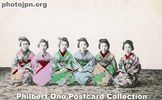
Brothel maids or prostitutes. Maids were employed to guide patrons to their rooms and serve sake and food. Or they could be low-class (cheap) prostitutes. Hand-colored, undivided back.1530 views
|
|

Film of Hannu Hautala ハンヌ・ハウタラ氏1520 viewsOn Friday September 16, it was Hannu Hautala night. It started with a film of Hannu at work in the wilderness. The film was beautifully accompanied by Heikki Sarmanto whose piano-playing reacted spontaneously to the film as he watched it.
ハンヌ・ハウタラ氏は、フィンランドの一番有名なネィチャー写真家。クーサモ在住。まず、ハウタラ氏の仕事ぶりを紹介する短い映画が上映した。BGMはライブのピアノ。
|
|

Penis prayers1507 viewsThis penis monument (built in 1995 by a steel company) is next to Kanayama Shrine. This person praying is a Caucasian man, not a woman. I was aghast when he stood up and showed his manly face. His long blond hair made me think he was a woman...
|
|

Samurai armor with matchlock gun bullet holes.1503 viewsCreated by an experiment with matchlock gun fired at the body armor at over 50 meters aways, piercing both the front and back body armor.
|
|

Benten-do1502 views
|
|

White weeping cherry blossoms1491 views
|
|
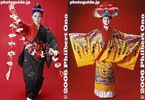
Okinawan Kimono1472 viewsOkinawa is a chain of subtropical islands in southern Japan between Kyushu and Taiwan. It developed its own language and culture while it was an independent kingdom centuries ago. Okinawan kimono, hairstyles, and dances therefore look quite different from the rest of Japan.
On the left is an Okinawan dancer wearing a kimono with her right arm exposed outside the sleeve. The dance is called "Nuchibana" (flower lei) featuring a string of red and white flowers. The dance expresses the feelings of a young woman in love.
The dancer on the right is wearing an Okinawan kimono called the bingata, perhaps Okinawa's most famous kimono. The design is made by applying dyes through a stencil. It was originally worn by Okinawa's royal family members. It is now the costume of a slow-moving Okinawan dance called "Yotsudake."
|
|

1. Fuji Murasaki (Purple Wisteria)1468 views
|
|

Snip by Yokozuna Asashoryu and a symbolic passing of the baton from one foreign yokozuna to the next (and only) foreign yokozuna.1466 viewsMongolia's Golden Age of Sumo has begun.
|
|

Kamogawa Odori Geisha Dance, Kyoto1463 viewsA scene from the annual Kamogawa Odori dance held in May in Kyoto. She wears a multi-layer kimono whose colors contrast well with each other. This type of kimono was worn by the nobility.
See more photos of this dance here.
|
|

Yuka-chan, A.B.S.UNIDOS DO URBANA based in Nagoya at Asakusa Samba 2008.1453 views
|
|

1972 Buick Riviera1446 views
|
|

Waving the sacred sakaki branch to bless all of us1442 views
|
|

1. Fuji Murasaki (Purple Wisteria)1437 views
|
|
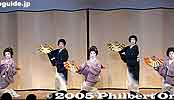
"Hana no Kai" Dance by Kagurazaka geisha1434 viewsThe "Hana no Kai" geisha dance is held annually by geisha in Kagurazaka, one of Tokyo's major geisha districts. "Hana" means livley or gaudy. And "Kai" can mean gathering or party.
They held two shows on the same day. This was the second show starting at 3 pm on April 16, 2005. It lasted till about 4:45 pm.
|
|

Banner with ukiyoe shunga-style painting of a penis.1429 views
|
|

Kanayama Shrine altar offerings1422 viewsNotice the male and female mochi offering.
|
|

Asakusa Samba Carnival1416 views
|
|

Costume Player1414 viewsPurin from Pokemon.
See more photos of cosplayers here.
|
|

1410 views
|
|

A representative of the shrine parishioners offer prayers.1402 views
|
|

1. Fuji Murasaki (Purple Wisteria)1398 views
|
|

It might look light brown here, but it looks more pinkish. It is carved in winter from a hinoki cypress tree by a master artisan wearing ceremonially-purified clothing and using traditional tools.1387 views
|
|

Also watch my Karuta hajime video here.1369 views
|
|
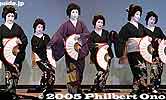
1368 views
|
|

Plum Blossom Queen at Kairakuen Station1365 viewsShe was passing out maps of the garden. It was a nice touch to see two of these kimono beauties greeting us.
|
|

Pubic hair not included. Perhaps that's why it doesn't look so obscene.1363 views
|
|
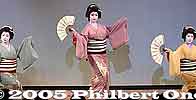
Eight Views of Tatsumi (巽八景)1361 viewsThe second number was about the Tatsumi and Monzen-nakacho (Fukagawa) district in Koto Ward, Tokyo. The dance reflects the chic and bravado of the area (in the old days) which was one of Tokyo's gay quarters with geisha as well.
|
|

YOKOSUKA, Japan (Sept. 25, 2008) Sailors aboard the aircraft carrier USS George Washington (CVN 73) form the phrase "Hajimemashite," which means "Nice to meet you" in Japanese, as they arrive at Fleet Activities Yokosuka.1359 viewsYOKOSUKA, Japan (Sept. 25, 2008) Sailors aboard the aircraft carrier USS George Washington (CVN 73) form the phrase "Hajimemashite," which means "Nice to meet you" in Japanese, as they arrive at Fleet Activities Yokosuka, Japan. George Washington and Carrier Air Wing 5 will be operating from Fleet Activities Yokosuka as the U.S. Navy's only forward-deployed aircraft carrier. U.S. Navy photo by Mass Communication Specialist 2nd Class Clifford L. H. Davis (Released)
|
|

Maid with paws...1353 views
|
|

Finnish Museum of Photography フィンランド写真美術館の展示室1347 viewsLarge, impressive space. The bookshop also had a good collection of photo books.
相当広いスペースです。一階だけですが、いくつかの展示部屋が仕切っていた。
|
|

Palanquin maidens.1347 views
|
|

Kanamara Festival かなまら祭1344 viewsKawasaki, Kanagawa.
|
|

Dec. 23, 2004 at 8:30 am: Across the street from the Imperial Palace. Dec. 23 and Jan. 2 are the only two days when the general public is allowed to enter the palace to greet the Emperor and his family.1342 viewsA visit to the Imperial Palace by the general public is called "ippan sanga" in Japanese (一般参賀).
On the Emperor's birthday, the Imperial Palace can be entered only at certain locations. You have to find out where they are and stand in line there. Just go near the Imperial Palace and ask a policeman where you can stand in line. You otherwise cannot enter the grounds. The huge, graveled plaza where you can see Nijubashi Bridge is closed off by police.
While standing in line here, we received free paper Japanese flags.
|
|

Kanamara Boat portable shrine (boat-shaped loaded with a phallus) was donated by a steel company. かなまら舟神1341 viewsThere are three portable shrines (called mikoshi). The Kanamara mikoshi (the original portable shrine), Kanamara-bune mikoshi (shaped like a boat), and Elizabeth mikoshi (pink giant). All three are carried during a procession around town. The Elizabeth mikoshi is carried by she-males. ("New half" in Japanese. Go ahead and laugh if you want.)
|
|

Even Santa Claus came (from Finland??). I'm told that they might be Finns. (Santa is from Finland.)1339 views
|
|

Finnish Museum of Photography フィンランド写真美術館1335 viewsIt is in a complex called the Cable Factory since it used to be a cable factory. The photo museum is housed in the large building on the left. The museum even once held a Japanese photography exhibition in 2001 which had traveled from Sweden. They still had the exhibition catalog in stock so I bought one.
The complex also houses other cultural facilities like dance theaters and art galleries.
Web site: fmp.fi
元のケーブル生産工場が現在美術・文化施設となっている。2001年にスウェーデンから来た日本の写真展も開催された。その図録が館内のショップでまだ販売されて一冊買った。
|
|

An altar in the Iga-ryu Ninja House.1332 views
|
|

This was the only one who had a smile. The others were quite serious and solemn.1331 views
|
|

Art work on the cart1320 views
|
|

Matsuyama Castle1319 views
|
|

Ouran High School Host Club1319 views
|
|

Hula kahiko started with a chant. ショーは夜の8:45〜9:45、フラカヒコで始まった。8月5日の第三の夜は雷雨のため中止となった。これらの写真は4日と6日に撮影。毎晩、ちょっと違うショーだった1318 views
|
|
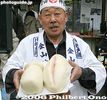
Male and female made of mochi. Both were offerings at the shrine.1311 views
|
|

Edo Geisha, She was the only one with a smile.1304 views
|
|

Lets you escape to the next room instantly, or climb up or down the ladder on the right wall.1303 views
|
|

Yokozuna Musashimaru1301 viewsHis last dohyo-iri.
|
|

Gozensai ceremony before the start of the penis procession. Tagata Shrine Honen Matsuri1298 views
|
|

Stockings1293 views
|
|

Paper plane sculpture1289 views
|
|

1972 Buick Riviera, one of my all-time favorites, lowrider or not.1281 views
|
|

The star and main focus of the festival and procession, the oiran or tayu courtesan.1270 views
|
|

1265 viewsAfter the dance, this geisha posed with us for a picture.
|
|

Musashimaru's final dohyo-iri1264 views
|
|

Plum Blossom Queen1263 views
|
|

Yuka-chan, A.B.S.UNIDOS DO URBANA based in Nagoya at Asakusa Samba 2006.1260 views
|
|

1259 viewsNotice that the kimono design shows waves.
|
|

Toshi-gami deity of harvests.1257 views
|
|

Mt. Fuji and Lake Yamanaka1246 views
|
|

Hojo Masako worships at Asakusa Temple. 北条政子 浅草寺参拝1244 views
|
|

悋気しゃんすな1234 viewsSolo number performed by Maiko (her name). 舞子
|
|

Unlike normal kimono, she wears the obi sashi in the front instead of the back. This is so that she can show off her beautiful obi which would otherwise be covered by the uchikake outer garment.1233 views
|
|

Pepper bombs to blind you.1230 views
|
|

Gozensai prayer ceremony before the start of the procession.1227 views
|
|

Koka Ninja House (Koka-ryu Ninjutsu Yashiki) is the former residence of Mochizuki Izumonokami, the leading Koga ninja family of the 53 Koka ninja families. 望月出雲守 MAP1227 viewsThe house is in its original location in the Koka area of Shiga Prefecture.
|
|

1227 views
|
|

The Ninja House, built in 1703, is owned and maintained by a local medicine company having ninja roots. Many Koka ninja were makers of medicine as a front for their clandestine activities. This background also made them expert at making gunpowder.1214 viewsNot a National Historic Site, but it should be.
|
|

1. Kagurazakari 神楽ざかり1212 views
|
|

Geisha catching a taxi home1210 viewsPhoto by Kevin Mihaly.
|
|

The first demo is this swinging wall.1210 views
|
|

As a theme park, the Koka-no-Sato Ninjutsu-mura or Koka Ninja Village offers a good tourist sampling of ninja in a hidden village of former ninja houses transplanted to this "village." Entrance to Koka Ninja Village, tucked away in a hidden, lus1209 viewsEntrance to Koka Ninja Village, tucked away in a hidden, lush forest. Quite far from the nearest train station (Koka Station on the Kusatsu Line). You can call them from the train station to be picked up.
|
|
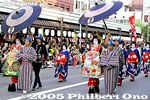
Oiran Dochu Procession. This picture was taken in the 1990s when they had two oiran in the festival. Now they have only one. 花の吉原おいらん道中1208 views
|
|

What would a ninja museum be without a display of shuriken?1206 views
|
|

Mistress Okichi, the infamous mistress of Townsend Harris, America's first ambassador to Japan when he was in Shimoda. Another mistress was provided to Harris' interpreter.1204 viewsOkichi was the infamous mistress of Townsend Harris, America's first ambassador to Japan. Another mistress was provided to Harris' interpreter.
黒船来航・浦賀奉行
|
|
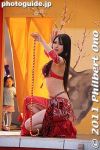
Belly dancer at Yushima Tenjin Plum Blossom Festival. Tokyo.1204 views
|
|

The red cloth is the blood after the demon inside the vagina bit the phallus (Old photo)1203 viewsThis picture was taken in the 1980s.
|
|

Shrine maiden1198 views
|
|

Belly dancer at Fukushima Waraji Matsuri.1198 views
|
|
|

Sacred Balls. Put in money and rub the left and right ball for family safety, business prosperity, safe childbirth, etc. 珍宝窟1192 views
|
|

Tekomai geisha costume is partially masculine with trousers instead of skirts. Their right shoulder is "exposed" showing a flower design. They carry a red paper lantern imprinted with their names and use their right hand to drag a wand.1191 views"Asakusa" is written on her lantern. 手古舞
|
|

10:24 am: After 3 min. on the balcony, they were gone. We waited almost 2 hours for a 3-min. appearance. But I think it's something you should do at least once while in Japan.1190 views
|
|

Belly dancer at Yushima Tenjin Plum Blossom Festival. Tokyo.1189 views
|
|

1187 views
|
|

Entrance for state guests. This is where heads of state and other royalty enter this building.1185 views
|
|

Way to Tagata Shrine from Tagata Jinja-mae Station. Shrine famous for numerous phallic objects used as offerings to the gods. The 1500-year-old shrine worships a deity called Tamahime-no-Mikoto who was a daughter of a powerful local lord from the 5th c.1185 viewsThe Honen-sai or Honen (Hounen) Matsuri is held by Tagata Jinja on March 15 to pray for an abundant harvest. "Honen" literally means "Year of abudant harvest." Since a giant penis is used as an offering, it is popularly called the "penis festival."
The shrine is near Tagata Jinja-mae Station on the Meitetsu Railways' Komaki Line. From Shin-Nagoya Station or Shin-Gifu Station, go to Inuyama Station and transfer to the Komaki Line.
|
|
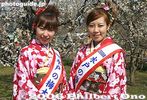
Plum Blossom Queens in Kairakuen, Mito1181 views
|
|

Panasonic Lumix girl at CP+ 2011 Camera Show.1181 views
|
|

The chigo parade of bygone days was much longer with a lot more kids. 昔の築地本願寺の花まつり: かなり長い行列でした。1179 views
|
|

Yokosuka, Japan (Sept. 22, 2005) - Students from Ikego Elementary School, Japan, experience first-hand what it is like to live in ship's berthing during a tour aboard the conventionally powered aircraft carrier USS Kitty Hawk.1176 viewsYokosuka, Japan (Sept. 22, 2005) - Students from Ikego Elementary School, Japan, experience first-hand what it is like to live in ship's berthing during a tour aboard the conventionally powered aircraft carrier USS Kitty Hawk (CV 63). During the tour the students visited the flight deck, forecastle, hangar bay and an unoccupied berthing area while learning about the life of Sailors aboard a U.S. Navy ship. U.S. Navy photo by Photographer's Mate Airman Matthew Reinhardt (RELEASED)
|
|

1174 views
|
|

Great summer day for the beach at Omi-Maiko, one of the most popular and whitest beaches on Lake Biwa.1171 views
|
|

San-mon Gate. Built in 1802. 三門1170 views
|
|

Belly dancer at Fukushima Waraji Matsuri.1170 views
|
|

Oiran Dochu Procession1168 views
|
|

Oiran dances.1167 views
|
|

Hula1166 views
|
|

Shibuya Station, Hachiko Exit 渋谷駅 ハチ公口1165 views
|
|

Inside Kanayama Shrine 金山神社1164 viewsKanayama Shrine is dedicated to a pair of gods named Kanayama Hikonokami and Kanayama Himenokami 金山比古神(かなやまひこのかみ) 金山比売神(かなやまひめのかみ. According to legend, when the main Shinto god named Izanami gave birth to the God of Fire, her lower abdomen got burned. These two Kanayama gods helped to heal her birth wound. Thus, these two gods came to be known as the gods of childbirth and healing of the lower abdomen. They later came to be worshipped as fertility gods, protector of sexually-transmitted diseases (AIDS, etc.), and successful marriage. They are also the gods of bellows (you can see it on the left of the fireplace above), so blacksmiths (who use bellows to fan the fire) also worship this shrine.
|
|
|

1158 views
|
|

Pregnant women also attend the festival. As well as mothers with a young baby coming to give thanks.1156 views
|
|

1154 views
|
|

Lollipops (mass produced)1151 viewsThe wrapping is printed with a prayer for conceiving.
|
|

Live orchestra playing swing jazz. 有川新二&ザ・グレイ・ラスカルズオーケストラ「なつかしのスウイングジャズ」1151 views
|
|

The Mizugumo Water Spider Pond where you can walk on water. A few visitors, wearing ninja costumes, try it out.1150 views
|
|

Yuka-chan, A.B.S.UNIDOS DO URBANA based in Nagoya at Asakusa Samba 2006.1149 views
|
|

1147 views
|
|
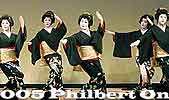
Finale1144 views
|
|

1143 views
|
|

Prayers for a child written on these votive tablets (ema)1143 views
|
|

Asashoryu sips water offered by Ozeki Chiyotaikai1141 viewsAs soon as Asashoryu entered the arena, many wrestlers went up to him to offer water as a show of respect.
|
|

The old Kanayama Shrine1141 views
|
|

Green aura1140 views
|
|

Näränkä farmhouse for rent 元牧場の家1139 viewsA farming family used to live here from 1841 to 1970. This was their house. The living conditions were quite severe during winter, but they were self-sufficient. The children had to walk for hours to attend school.
This house has been renovated and it is available for short-term rental. It can accommodate maybe 10-15 people. A sauna is also within the property. It's quite isolated so you have a lot of privacy.
For reservations and more info: http://www.kuusamobirds.net/en/tourism44.php
1841~1970年に農業の家族が住んでいた民家。この家は、リフォームされて短期間に貸し出し用。かなり大きいで10人以上が泊まれる。勿論、新婚さんも使用できる。サウナも別の建物にある。
|
|

Gozensai ceremony before the start of the procession.1137 views
|
|

She-male (or maybe just a drag queen, I couldn't visually or physically confirm)1136 views
|
|

Sexy model at CP+ photo show in Yokohama1134 views
|
|

All the baby-carrying men must be careful not to slip and fall in the mud. Warabi Hadaka Matsuri in Yotsukaido, Chiba.1133 views
|
|

1133 views
|
|

Music and singing accompaniment1130 viewsAll numbers was accompanied by live music and singing.
|
|

Ready for the procession1130 views
|
|

1128 views
|
|

Kagurazaka Geisha1128 views
|
|

Oiran Dochu Procession1126 views花の吉原おいらん道中
|
|
| 71052 files on 282 page(s) |
1 |
 |
 |
 |
 |
|